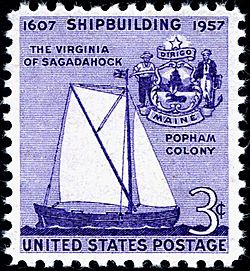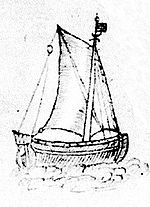Virginia (pinnace) facts for kids
class="infobox " style="float: right; clear: right; width: 315px; border-spacing: 2px; text-align: left; font-size: 90%;"
| colspan="2" style="text-align: center; font-size: 90%; line-height: 1.5em;" | 
|}
The Virginia or Virginia of Sagadahoc was a special type of ship called a pinnace. It was built by English colonists in 1607–1608 at the Popham Colony. This colony was in what is now Phippsburg, Maine. The Virginia was the very first English ocean-going ship ever built in the New World (North America). Building this ship showed that the new colony could create its own vessels.
The Virginia was built near the Kennebec River. We don't know all the exact details of its design. But old records suggest it was about 30 tons in weight. It was also about 50 ft (15 m) long and 14 ft 6 in (4.42 m) wide. This ship was designed to be very flexible. It could be used for exploring the coast or even for long trips across the ocean.
Contents
- The Popham Colony and Shipbuilding
- How the Virginia Was Designed
- Journeys of the Virginia
- Building a Replica
The Popham Colony and Shipbuilding
The Popham Colony was also known as the Sagadahoc Colony. It was started in 1607 by the Plymouth Company. This colony was located in what is now Phippsburg, Maine. Its main goals were to:
- Set up an English presence in North America.
- Look for gold and other valuable things.
- Find the Northwest Passage, a sea route to Asia.
- Trade with the native people, especially for fur.
- Prove that the area had all the materials needed to build ships.
During the 14 months the colony existed, the colonists completed a huge project. They built the 30-ton ship called Virginia. This was the first known ocean-going ship built by Europeans in what would become the United States. It showed that the colony was ready for shipbuilding. The Virginia's design was very flexible. It could be used for exploring the coast, fishing in the North Atlantic, or even crossing the Atlantic Ocean.
The word "pinnace" could mean different things. It could be a large ship or a smaller boat carried by bigger ships. The Virginia was a medium-sized pinnace at 30 tons. It was mainly used for exploring the coast and for defense. To sail the Virginia to England, its sails and ropes were changed for ocean travel.
How the Virginia Was Designed
The Virginia was likely about 56 feet long and 15 feet 5 inches wide. It had a flat main deck. When fully loaded, it sat about 6 feet 5 inches deep in the water. Its side (freeboard) was less than 2 feet above the water. The ship weighed about 30 tons. You can see sketches of how the replica's hull and frame look online.
Pinnace on Hunt's 1607 Plan
For ocean trips, the Virginia probably had a large main mast with square sails. It also had a smaller second mast with a gaff rig (a type of sail). A small square sail was also under the bowsprit (a pole at the front of the ship). Many pinnaces had a main mast big enough to carry a small topsail (an extra sail above the main one).
For coastal work, the Virginia would have used a different set of sails. This included a mainsail that ran from front to back and one headsail (at the front). How the coastal sails were changed for an ocean trip is still being studied. A drawing by John Walker shows the Virginia with a sail on its back mast that looks like a lateen sail (a triangular sail). This shows how versatile these small pinnaces were. They could be fishing boats, storage ships, or even supply ships towed by larger vessels.
There is a small drawing from the 1600s of a pinnace. It is on John Hunt's map from October 8, 1607. This map shows Fort St George at the Popham Colony. This map was found in Spain. People believe this boat is the 30-ton pinnace Virginia. It was built in 1607–1608 at the Popham colony. The ship was built by eye, without detailed plans, under the direction of a shipbuilder named Digby from London.
Journeys of the Virginia
On October 17, 1608, the Popham Colony was closed down. The colonists boarded the Virginia and a supply ship called Mary and John. They sailed back to England. The Virginia was still strong after its first ocean trip. It had more work to do.
On May 23, 1609, a new plan for the Virginia Company was signed by King James I of England. This plan gave the Company more land and power. This led to a new effort to help the colony at Jamestown.
The Virginia was part of a fleet of nine ships. This fleet was known as the Third Supply. It carried 500-600 people. The ships left Falmouth, Cornwall, England, on June 8, 1609. They headed straight for the Virginia colony. The main ship of this fleet was the Sea Venture. It was the first ship built just for carrying people to a new land.
The fleet ran into a powerful hurricane near Bermuda in July 1609. Two ships, the Catch and the Sea Venture, were lost. The Virginia left the fleet near the Azores islands. It probably went back to England. It arrived safely at Jamestown on October 3, 1609. It brought 16 soldiers. This was six weeks after the other ships that were damaged in the hurricane. It seems the Virginia missed the storm.
The damaged ships of the Third Supply arrived in August. They brought 300 colonists and very few supplies. The Jamestown colony was in trouble. Its leaders were fighting, and the Powhatan tribe was attacking. When the Virginia arrived in early October, John Smith, the leader of Jamestown, was badly hurt. James Davies was sent with the Virginia to lead Fort Algernon at Point Comfort.
By June 1610, over 80% of the colonists at Jamestown had died. The remaining 60 colonists boarded the Virginia and another supply ship. They left Jamestown. While still in the James River, they met the ships of Lord De la Warr. He was the new governor of Virginia. He brought the Fourth Supply mission. So, the colonists returned to Jamestown.
The last time the Virginia was mentioned in history was in June 1610. Captain Robert Tyndall was told to take the Virginia to catch fish in the Chesapeake Bay.
Building a Replica
The pinnace Virginia is being rebuilt by a group of volunteers. This group is called Maine's First Ship. They are building it near where the original ship was made. The design for the replica was finished in 2007. This was after a lot of research, as there wasn't much old information. The first part of the ship (the keel) was laid down on July 3, 2011.
The rebuilding is happening in Bath, Maine. The new Virginia is expected to be launched in 2022. The goal is to create a floating classroom for students of all ages. It will help people learn about Maine's early shipbuilding history. It will also teach about the Popham Colony and its connection with the Wabanaki people.
| History | |
|---|---|
| Name | Virginia |
| Namesake | Queen Elizabeth I |
| Ordered | Summer, 1607 |
| Builder | Digby of London |
| Laid down | Autumn, 1607 |
| Launched | Spring, 1608 |
| In service | Spring 1608 |
| Homeport | Popham Colony, then Jamestown, Virginia Colony |
| Fate | unknown |
| General characteristics | |
| Type | pinnace |
| Displacement | 30 tons |
| Length | 50 ft (15 m) |
| Beam | 14.5 ft (4.4 m) |
| Draft | 6.5 ft (2.0 m) |
| Propulsion | At least three rigs possible: a) square-rigged main mast, gaff-rigged second mast, square sail under bowsprit, topsail; b) fore-and-aft rigged with sprit mainsail; and/or c) aft-rigged mizzen mast with lateen sail. |
| Range | coastal, ocean |
| Armour | None |
| Notes | Virginia was the first English ship built in the Americas to cross the Atlantic. Virginia is a fine example of the 'small' pinnace design which could be fitted with a variety of rigs, and thereby had great flexibility as to designated tasks. |


